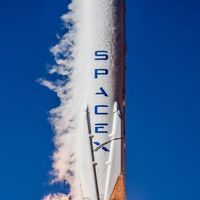SpaceX: Pioneering the Final Frontier
September 10, 2024, 9:51 pm

Location: United States, District of Columbia, Washington
Employees: 5001-10000
Founded date: 2002
Total raised: $7.53B

Location: United States, Maryland, Greenbelt
Employees: 10001+
Founded date: 1958
Total raised: $25.7B
SpaceX is not just a company; it’s a vision. A vision that stretches beyond Earth, reaching for the stars. Elon Musk, the man behind the curtain, has set his sights on Mars. The plan? An unmanned Starship mission in 2026, followed by a crewed mission in 2028. This is not just a dream; it’s a blueprint for humanity’s future.
The universe is vast, and Mars is our next door neighbor. Every 26 months, Earth and Mars align perfectly for interplanetary travel. This cosmic rhythm is the heartbeat of SpaceX’s ambitions. Musk believes that if the first missions succeed, the floodgates will open. Soon, we could see a surge of flights to the Red Planet. Within two decades, he envisions a self-sustaining city on Mars. A city where humans can thrive, not just survive.
Starship is the key. Standing at 122 meters, it’s the tallest and most powerful rocket ever built. It’s a marvel of engineering, crafted from stainless steel. The design is sleek, the purpose clear: complete reusability. SpaceX aims to return the Super Heavy booster to the launch pad after each flight. This will streamline inspections and repairs, making space travel more efficient.
In June 2024, SpaceX achieved a milestone. The fourth launch attempt of Starship was a success. This was the first time the Super Heavy rocket performed as intended. Now, the company is gearing up for its fifth launch. This time, they will attempt to land the Super Heavy booster back on the launch pad. It’s a bold move, but SpaceX thrives on challenges.
Meanwhile, another mission is brewing. The Polaris Dawn mission is set to make history. A crew of four private astronauts is preparing for a groundbreaking spacewalk. This will be the first-ever private spacewalk, a leap into the unknown. The crew includes a billionaire entrepreneur, a retired military pilot, and two SpaceX employees. They will launch aboard the Crew Dragon capsule, a spacecraft that has already proven its worth.
The stakes are high. This mission is not just about exploration; it’s about pushing boundaries. The astronauts will don new spacesuits, designed for the rigors of space. The mission is risky, but that’s the nature of exploration. Every step into the void is a step toward discovery.
SpaceX is at the forefront of a new era. The company is redefining what it means to be an astronaut. No longer are these journeys reserved for government agencies. Now, private citizens can join the ranks of space explorers. This democratization of space travel is revolutionary. It opens the door for innovation and creativity.
As the countdown to launch ticks away, excitement builds. The Kennedy Space Center buzzes with activity. Photographers capture the moment, remote cameras poised to document history. The Falcon 9 rocket stands tall, a symbol of human ingenuity. It’s a reminder that we are capable of great things.
The Polaris Dawn mission is not just a test of technology; it’s a test of human spirit. The crew will venture into the unknown, tethered to their spacecraft but free in spirit. They will float in the vastness of space, a reminder of our smallness in the grand scheme. Yet, in that smallness lies our greatest strength: the desire to explore.
SpaceX’s ambitions extend beyond Mars. The company is laying the groundwork for a multi-planetary future. Musk believes that spreading humanity across different planets will increase our chances of survival. It’s a bold claim, but one rooted in a deep understanding of our vulnerabilities.
The challenges are immense. Space travel is fraught with dangers. Yet, with each mission, SpaceX learns and adapts. The failures are stepping stones, not roadblocks. Each setback is a lesson, a chance to improve. This resilience is what sets SpaceX apart.
In the coming years, we will witness a transformation. Space travel will become more routine. The dream of colonizing Mars will inch closer to reality. The universe will no longer be a distant dream; it will be within our reach.
As we look to the stars, we must remember our roots. Earth is our home, but it is not our only home. The cosmos beckons, and SpaceX is leading the charge. With each launch, we are one step closer to becoming a multi-planetary species.
The future is bright. The stars are calling. And SpaceX is answering. The journey has just begun. Buckle up; it’s going to be an exhilarating ride.
The universe is vast, and Mars is our next door neighbor. Every 26 months, Earth and Mars align perfectly for interplanetary travel. This cosmic rhythm is the heartbeat of SpaceX’s ambitions. Musk believes that if the first missions succeed, the floodgates will open. Soon, we could see a surge of flights to the Red Planet. Within two decades, he envisions a self-sustaining city on Mars. A city where humans can thrive, not just survive.
Starship is the key. Standing at 122 meters, it’s the tallest and most powerful rocket ever built. It’s a marvel of engineering, crafted from stainless steel. The design is sleek, the purpose clear: complete reusability. SpaceX aims to return the Super Heavy booster to the launch pad after each flight. This will streamline inspections and repairs, making space travel more efficient.
In June 2024, SpaceX achieved a milestone. The fourth launch attempt of Starship was a success. This was the first time the Super Heavy rocket performed as intended. Now, the company is gearing up for its fifth launch. This time, they will attempt to land the Super Heavy booster back on the launch pad. It’s a bold move, but SpaceX thrives on challenges.
Meanwhile, another mission is brewing. The Polaris Dawn mission is set to make history. A crew of four private astronauts is preparing for a groundbreaking spacewalk. This will be the first-ever private spacewalk, a leap into the unknown. The crew includes a billionaire entrepreneur, a retired military pilot, and two SpaceX employees. They will launch aboard the Crew Dragon capsule, a spacecraft that has already proven its worth.
The stakes are high. This mission is not just about exploration; it’s about pushing boundaries. The astronauts will don new spacesuits, designed for the rigors of space. The mission is risky, but that’s the nature of exploration. Every step into the void is a step toward discovery.
SpaceX is at the forefront of a new era. The company is redefining what it means to be an astronaut. No longer are these journeys reserved for government agencies. Now, private citizens can join the ranks of space explorers. This democratization of space travel is revolutionary. It opens the door for innovation and creativity.
As the countdown to launch ticks away, excitement builds. The Kennedy Space Center buzzes with activity. Photographers capture the moment, remote cameras poised to document history. The Falcon 9 rocket stands tall, a symbol of human ingenuity. It’s a reminder that we are capable of great things.
The Polaris Dawn mission is not just a test of technology; it’s a test of human spirit. The crew will venture into the unknown, tethered to their spacecraft but free in spirit. They will float in the vastness of space, a reminder of our smallness in the grand scheme. Yet, in that smallness lies our greatest strength: the desire to explore.
SpaceX’s ambitions extend beyond Mars. The company is laying the groundwork for a multi-planetary future. Musk believes that spreading humanity across different planets will increase our chances of survival. It’s a bold claim, but one rooted in a deep understanding of our vulnerabilities.
The challenges are immense. Space travel is fraught with dangers. Yet, with each mission, SpaceX learns and adapts. The failures are stepping stones, not roadblocks. Each setback is a lesson, a chance to improve. This resilience is what sets SpaceX apart.
In the coming years, we will witness a transformation. Space travel will become more routine. The dream of colonizing Mars will inch closer to reality. The universe will no longer be a distant dream; it will be within our reach.
As we look to the stars, we must remember our roots. Earth is our home, but it is not our only home. The cosmos beckons, and SpaceX is leading the charge. With each launch, we are one step closer to becoming a multi-planetary species.
The future is bright. The stars are calling. And SpaceX is answering. The journey has just begun. Buckle up; it’s going to be an exhilarating ride.